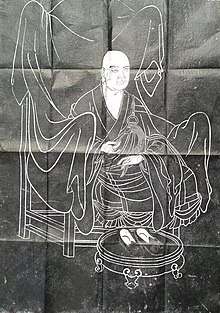Woncheuk
Woncheuk (613–696) was a Korean Buddhist monk who did most of his writing in China, though his legacy was transmitted by a disciple to Silla. One of the two star pupils of Xuanzang, his works and devotion to the translation projects was revered throughout China and Korea, even reaching Chinese rulers like Emperors Taizong and Gaozong of Tang and Empress Wu of Zhou.[1] His exegetical work was also revered and greatly influenced Tibetan Buddhism and the greater Himalayan region.
| Woncheuk | |
 | |
| Korean name | |
|---|---|
| Hangul | 원측 |
| Hanja | 圓測 |
| Revised Romanization | Woncheuk |
| McCune–Reischauer | Wŏnch'ŭk |
Nomenclature, orthography and etymology
The Zhengzhang Shangfang reconstruction of the Middle Chinese pronunciation of his name is 圓測 /ɦˠiuᴇnťʃʰɨk̚/.[2] Woncheuk (pinyin: Yuáncè) was also known as Chinese: 西明法師; pinyin: Xīmíng Fǎshī, which is a namesake attributed to the temple of the same name where he did his exegesis.
Biography
Korean born, he lived at Xi Ming Temple and studied at the commencement of the Tang dynasty with the great translator and exponent of Yogacara, the well-travelled Xuanzang. Through Xuanzang's tutelage, he focused upon the study of the Yogacara doctrine. Woncheuk authored commentaries on early Indian and Mahayana literature. Woncheuk died in China, in a temple in Loyang. Woncheuk is well known amongst scholars of Tibetan Buddhism and the Himalaya for his Commentary on the Saṃdhinirmocana sūtra. While in Tang China, Woncheuk took as a disciple a Korean-born monk named Dojeung (Chinese: 道證), who travelled to Silla in 692 and propounded and propagated Woncheuk's exegetical tradition there where it flourished.
Choo (2006: p. 125) holds that though the Heart Sutra is generally identified as within the auspice of the Second Turning of the Dharmacakra (Sanskrit), Woncheuk in his commentary provides an exegesis from the Third Turning:
Within the Mahāyāna doctrinal classification, the Heart Sūtra belongs to the Buddha's Second turning of the Wheel, the Emptiness period of Dharma, and most extant commentaries approach it from the perspective of the Mādhyamika doctrine of the Emptiness period (Chung, 1977:87). However, Wonch'uk interprets the Heart Sūtra from the Yogācāra perspective, and his Commentary therefore offers the reader a unique opportunity to examine the Mādhyamika doctrine of emptiness from the Yogācāra perspective.).[3]
Woncheuk contributed to the development of the Dharmic discourse of Essence-Function and Ekayāna.
Extant works
Choo (2006: p. 123) lists Woncheuk's three extant works, namely:
- the Commentary on the Heart Sutra (traditional Chinese: 般若心經贊), which is the first commentary on Xuanzang's translation of the Heart Sutra
- the Commentary on the Samdhinirmocana-sutra (traditional Chinese: 解深密經疏), which is the largest extant commentary on that sutra—called “the Great Chinese Commentary” by the eminent Vajrayana scholar Je Tsongkhapa
- the Commentary on the Benevolent King Sutra (traditional Chinese: 仁王般若經疏).[4]
Notes
- Benjamin Penny (2002), Religion and Biography in China and Tibet, p. 110
- Wiktionary sv 圓 and 測
- Choo, B. Hyun (2006). "An English Translation of the Banya paramilda simgyeong chan: Wonch'uk's Commentary on the Heart Sutra (Prajnaparamita-hrdaya-sutra)." cited in: International Journal of Buddhist Thought & Culture February 2006, Vol. 6, pp. 121–205. 2006. International Association for Buddhist Thought & Culture. Source: (accessed: Monday February 2, 2009), p. 125
- Choo, B. Hyun (2006). "An English Translation of the Banya paramilda simgyeong chan: Wonch'uk's Commentary on the Heart Sutra (Prajnaparamita-hrdaya-sutra)." cited in: International Journal of Buddhist Thought & Culture February 2006, Vol. 6, pp. 121–205. 2006. International Association for Buddhist Thought & Culture. Source: (accessed: February 2, 2009), p. 123
References
- Choo, B. Hyun (2006). "An English Translation of the Banya paramilda simgyeong chan: Wonch'uk's Commentary on the Heart Sutra (Prajnaparamita-hrdaya-sutra)." cited in: International Journal of Buddhist Thought & Culture February 2006, Vol.6, pp. 121–205. 2006 International Association for Buddhist Thought & Culture. Source: (accessed: February 2, 2009)
- Chung, Byung Cho (1977). "Wonch'uk ui Banya Simgyeong Chan Yon-ku (The Study of Wonch'uk's Commentary on the Heart Sūtra)." The Journal of Korean Studies. No.9, Winter. Seoul: II Ji Sa.